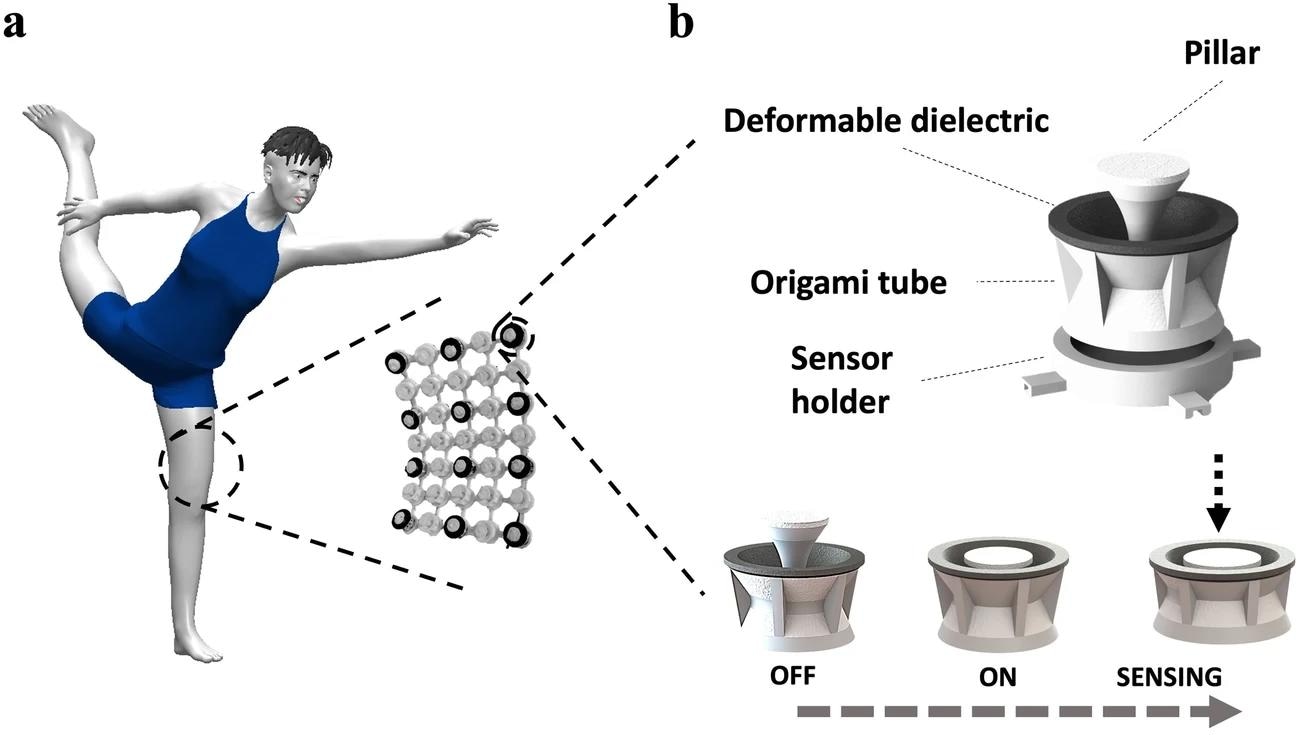 By Nidhi DhullApr 18 2024Reviewed by Susha Cheriyedath, M.Sc.
By Nidhi DhullApr 18 2024Reviewed by Susha Cheriyedath, M.Sc.A recent study published in npj Flexible Electronics proposes a wireless pressure monitoring system using a 3D-printed origami pressure sensor array. It is equipped with customizable architecture sensors to overcome the limits of existing commercial pressure mats. This cost-effective and adaptable pressure monitoring system can work in the 70 to 2500 kPa pressure range.
 a Schematic of a customizable Pillar-Origami pressure mapping mat for different applications of healthcare monitoring. b Schematic of Pillar-Origami pressure sensor unit, describing its components and characteristics in three states of ON, OFF, and Sensing. Image Credit: https://www.nature.com/articles/s41528-024-00309-z
a Schematic of a customizable Pillar-Origami pressure mapping mat for different applications of healthcare monitoring. b Schematic of Pillar-Origami pressure sensor unit, describing its components and characteristics in three states of ON, OFF, and Sensing. Image Credit: https://www.nature.com/articles/s41528-024-00309-z
Background
Monitoring pressure is crucial for individuals in physically demanding roles, including laborers, athletes, and the elderly. Pressure data gathered through advanced monitoring systems and sensors helps identify biomechanical irregularities, aids in the design of ergonomic footwear insoles, and enhances sports training methodologies.
Recent advancements have focused on developing wearable pressure monitoring systems that improve performance metrics such as detection range, sensitivity, linearity, durability, and response time. These systems often employ a combination of flexible substrates for sensing and conductive materials for electrodes to optimize these characteristics, exploring technologies like piezoresistive, piezoelectric, and triboelectric sensors. Nonetheless, commercial pressure sensors still face challenges related to size limitations and accuracy.
Moreover, the manufacturing techniques for these sensors, which include force-based, electric field-assisted, and light-assisted methods, often require complex processes in specialized equipment within clean room environments, significantly raising production costs. Additionally, damage to a component like a pressure monitoring mat typically necessitates replacing the entire device. To address these issues, researchers in this study have utilized 3D printing to create a flexible pressure sensor array featuring a novel pillar-origami structure.
Pressure Monitoring System Fabrication
The researchers utilized dual nozzle fused deposition modeling (FDM) 3D printing technology, which enables the simultaneous production of the sensor's flexible structure and electrodes in a single process. Initially, a 3D model of the sensor was created using Solid Works 2022 software, which includes two primary components: the array and units. These components were printed using a fused filament fabrication 3D printer, followed by the integration of dummy/sensing units into the array.
The study focused on developing a capacitive pressure sensor, which required the preparation of a separate dielectric structure alongside the base. This dual-structure design features an origami tube reinforced with ribs and a central pillar. The application of minimal pressure deforms this dielectric structure—through buckling of the pillar and the origami component—thereby altering its capacitance. To minimize the influence of the human body on device capacitance, human skin was used as one of the electrodes in the capacitance measurements.
Two pressure mapping devices were designed and assembled using this innovative method: a 150 x 150 mm device for foot pressure mapping and a 150 x 100 mm array tailored for sports applications. Each device comprises a pressure mat, a reference electrode, a data acquisition board, and a 5V power bank to power the board. A MATLAB script was employed to wirelessly receive and contour plot the sensing data from the data acquisition board.
The performance of these devices was rigorously tested in conditions that mimic real-world use. For instance, the foot pressure mapping device was used to record the pressure distribution on a human foot in four different postures during various physical activities. Similarly, another device was integrated into the protective pad of an athlete to measure impact forces during sports, demonstrating the practical applications of this technology.
Results
The proposed pressure sensor with a pillar-origami structure offered precise stiffness control, effectively filtering skin deformations and enabling capacitive pressure sensing. The proposed architectural design exhibits a finely tunable pressure measurement range from 70 to 2500 kPa with sensitivity between 0.01 kPa-1 and 0.0002 kPa-1 and a response time of only 800 milliseconds. Additionally, the entire device is portable, and pressure mapping can be monitored in real-time and online.
Shape programmability is an essential feature of the fabricated 3D pressure sensor, as its mechanical properties can be controlled by varying the geometrical parameters. Thus, the pressure range and sensitivity of the device can be optimized by varying the origami tube thickness, origami folding angle, pillar diameter, gap between the upper surface of the pillar and origami tube, and the number of supporting ribs.
The FDM 3D printing technology used in the study resolves adhesion issues generally encountered in multi-layer sensors. It allows modification of the dimensions, shape, and resolution of the pressure mat according to the user’s specifications. In addition, the modular sensor array integrated into the pressure monitoring system facilitates easy maintenance.
Conclusion
Overall, this paper successfully demonstrated a wireless pressure monitoring mat that can overcome the adaptability and accuracy issues in the existing pressure sensors. In case of damage within the sensor array, it is possible to replace individual sensing units instead of the entire device, making device maintenance economical and sustainable along with extended operational functionality.
With possible applications in wireless foot pressure mapping and sports protection pads, the proposed pressure monitoring system can be a significant milestone in the development of flexible and customizable pressure sensor technology.
Journal Reference
Moeinnia, H., Agron, D. J., Ganzert, C., Schubert, L., & Kim, W. S. (2024). Wireless pressure monitoring system utilizing a 3D-printed Origami pressure sensor array. npj Flexible Electronics, 8(1), 1–8. https://doi.org/10.1038/s41528-024-00309-z, https://www.nature.com/articles/s41528-024-00309-z
Disclaimer: The views expressed here are those of the author expressed in their private capacity and do not necessarily represent the views of AZoM.com Limited T/A AZoNetwork the owner and operator of this website. This disclaimer forms part of the Terms and conditions of use of this website.